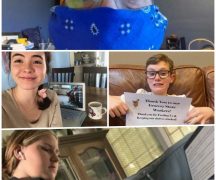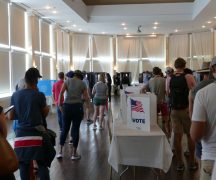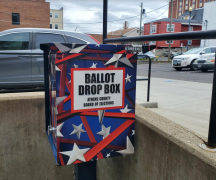Ohio Capital Journal
The new coronavirus has killed more than 209,000 Americans — including 4,925 Ohioans — and infected the leader of the free world and the quarterback of the New England Patriots alike.
Yet still, Ohio’s legislative leaders have rebuffed any requirement that members and their staff wear masks at the Capitol.
Facial coverings are among the cheapest and most effective tools for staving off the virus, as evidenced by peer-reviewed science. CDC Director Robert Redfield has described them as more effective than any vaccine.
Prominent medical groups and journals like the American Medical Association, the Cleveland Clinic, or the New England Journal of Medicine support universal masking policies as a means to prevent the spread of COVID-19.
Gov. Mike DeWine’s administration issued a statewide mask mandate in July, but maintains that enforcing the mandate in judicial or legislative buildings would amount to a violation of the separation of powers enshrined in the U.S. Constitution.
“What the two branches of government do, I can’t control that,” he said to reporters Friday in a special press conference after President Donald Trump tested positive for COVID-19.
The Ohio Statehouse is perhaps the only public building in the state whose patrons need not wear masks under the public health decree.
Senate President Larry Obhof, R-Medina, in a June 29 memo, “encouraged” staff to wear masks in public spaces of the Capitol but did not require it.
House staff are not required to wear masks, per a Sept. 16 human resources email obtained by the Ohio Capital Journal, unless they are in the common areas of the House office building that are “controlled by the governor.”
Spokespeople for Obhof and House Speaker Bob Cupp, R-Lima, did not respond to inquiries.
DeWine said Friday he’s not planning to expand the mask mandate to encapsulate the Statehouse but hinted that he suspects GOP lawmakers will come around on their stance against masks.
The business-as-usual appearance of a Statehouse filled with barefaced lawmakers at work stands in stark contrast to a country shuttered in at home or spaced out and masked up when out and about.
Generally, Republicans lawmakers have refused to wear masks and Democrats have. Some Republicans wear masks, some do in lower profile situations or keep them in their pockets, but the partisan contrast is unmistakable.
In the House, Republican leaders voted down a proposal from Democrats in May that would have required members and staff to wear masks.

“The small Democratic minority in the Ohio House is not going to govern what the majority does,” said House Majority Leader Bill Seitz after the vote. “They don’t have that kind of control over the duly elected representatives of the people.”
In an interview after the May 19 hearing, Seitz unsheathed a printout of two-month-old guidance from the Journal of American Medicine stating that masks are ineffective to prevent COVID-19. A spokesman later said the journal’s updated guidance supporting facial coverings “does not change Rep. Seitz’s feelings on the use of face masks.”
Among GOP lawmakers, Seitz is not alone. Rep. Candice Keller was asked to leave Gettysburg Visitor Center for refusing to wear a mask, per the Cincinnati Enquirer. Rep. Nino Vitale won’t wear a mask because “faces are the likeness of God.” Rep. Jon Cross said he doesn’t wear a mask because the legislature didn’t pass any law requiring as much.
Former House Speaker Larry Householder was not publicly seen in a facemask until his mid-July arrest in connection with a federal racketeering charge — the federal courthouse requires occupants to wear masks.
On Friday, Democratic Rep. Kent Smith, responding to Trump’s infection, said he has only seen “a few” House Republicans wearing masks during floor sessions while the “overwhelming majority” do not. He called on Cupp to implement a mask mandate.
“The work of the people need not become a super spreader event during a global pandemic without a treatment or cure,” he said. “To continue to ignore this threat is reckless, irresponsible, cowardly and ignorant.”
Ryan Smith, a former GOP House Speaker turned university president, declined an interview to discuss masks in the Statehouse.
“Sorry but that is not an issue I care to get in the middle of,” he said.

Members and staff alike have been infected. Democratic Sen. Tina Maharath as well as Republicans Sens. Bob Peterson and Frank Hoagland contracted the disease. Democratic Rep. Stephanie Howse contracted the virus as well this summer, as did Democratic Rep. Joe Miller, per a Friday Twitter post.
At least four legislative staff members were infected this summer, prompting the House to re-institute a work-from-home policy.
In all, the weekend proved to be a firehose of bad pandemic news. The country reeled from news of Trump’s positive test and related infections of three Republican U.S. Senators, senior members of Trump’s campaign, and (in an unrelated case) New England Patriots starting quarterback Cam Newton.
Meanwhile, new Ohio Department of Health data continued an “alarming” upward infection rate in Ohio, as DeWine described it Friday. Friday data reflected the largest one-day new caseload (1,495 new infections) since July, and the most deaths (88) reported in a day since early May.
***
Also from Ohio Capital Journal:
‘I just don’t trust the system any more.’ Voters on edge as election nears.

This is the first in a series of stories looking at voters’ concerns and voting issues in the 2020 election. Tomorrow: The truth about voter fraud and a look at voting machine security.
WASHINGTON — Widespread anxiety and confusion around voting, compounded by the pandemic that has spread to millions of Americans, including President Donald Trump.
A vastly underfunded and decentralized electoral system that could take days and possibly weeks to certify results.
Attempts to suppress voting, interfere with elections and cast doubt on the integrity of mail-in ballots — including by none other than the president.
These are but a few of the worries consuming U.S. voters in an unprecedented election year marked by more than 200,000 deaths from COVID-19, ongoing civil unrest over centuries of racial oppression and widespread unemployment.
Trump’s Friday announcement that he and first lady Melania Trump tested positive for the virus further complicates the uncertain election season. At least temporarily it will halt the president’s campaigning and possibly derail the remaining presidential debates. READ MORE
***
Abortions continue to decline in the state
As court battles continue over legislation related to abortion, the Ohio Department of Health last week reported a 2% decline in the procedures.
The annual report gathered information about abortions occurring in the state from confidential abortion reports and “post-abortion care reports for complications.”
Last year, 20,102 “induced pregnancy terminations” were reported in Ohio, according to the report. Ohio residents represented 94.1% of those, but the total was part of a decrease that has continued for years.
“Overall, since 2001 there has been a steady decline in terminations,” the report stated, adding that the annual decline was an average of 960 abortions per year.
According to the data, 61% (12,257) of the abortions were at less than nine-weeks gestation, which was more than half of all abortions in 2019. More than 5,000 abortions (26.5%) were induced at nine to 12 weeks, followed by 2,168 at 13 to 18 weeks. READ MORE





